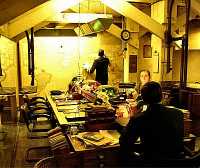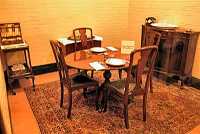
|
||
Churchill Wars Rooms in London (formally Cabinet War Rooms) - Safe Underground Location for Government During the WarOn May 10 1940 Winston Churchill became Prime Minister after Neville Chamberlain resigned from the post. On the 70 anniversary of this event (May 2010) this Museum changed its name to the Churchill War Museum to commemorate this event. So, what we all knew as the Cabinet War rooms and Churchill Museum are now one. During the Second World War, from 1 September 1939 until May 1945, London was under threat of air raid. These underground rooms with reinforced ceilings and walls, were used from 1940 to mid 1945. The Cabinet War Rooms are located across from the Houses of Parliament, next to the Churchill Museum. This sprawling complex covers three acres. Winston Churchill and his War Cabinet would convene here when there was a German air raid. From here they guided the course of the war to its ultimate victory. Many rooms for different functions are house here. These included; communications rooms, a hospital, canteen, firing range and dormitories for several hundred staff. Today the most interesting rooms are open to the public. Many of them are left exactly as they were when the facility was vacated on 16 August 1945. Highlights of the Churchill War Rooms (Cabinet War Rooms)Map RoomThe best example of a room left as it was is the Map Room. Still occupying their final positions are coloured drawing pins. These charted the progress of troops throughout the course of the war on a huge map of the world. The last reports plaster the walls, and the old record books lie unmoved from the desks. During wartime this room was a frenzied hub of activity. It was operational 24/7. Officers were constantly collating incoming information and updating the maps accordingly. Several officers manned the bank of colour-coded telephones. Known as the "Beauty Chorus", these are in the centre of the room. These phones were outfitted with flashing lights rather than bells. Each one was a direct line to a military department, intelligence service or the war rooms' own international switchboard. Look out for the blackboard on a pillar at the table's end. This was used to note the numbers of enemy aircraft destroyed each day during the Battle of Britain. Prime Minster Winston Churchill's BedroomNext door is Churchill's Bedroom. This is a tiny room no larger than an average prison cell. It was situated adjoining the Map Room at the Prime Minister's request. Churchill would often hold meetings here in the mornings. Sitting up in his bed and smoking a cigar. He made four of his stirring war speeches to the nation from the microphones situated on his desk. Notably including an invasion warning on 11 September 1940 and the announcement of America joining the War, after the attack on Pearl Harbour. In 1943 the bedroom's broom closet was converted into the "Transatlantic Telephone Room". A tiny secretive space with a special scrambler phone in it. Churchill communicated on it with American president Franklin D. Roosevelt. The Churchill SuiteSome additional private rooms of Churchill are located across the hall in the Churchill Suite. These include;
|
||

